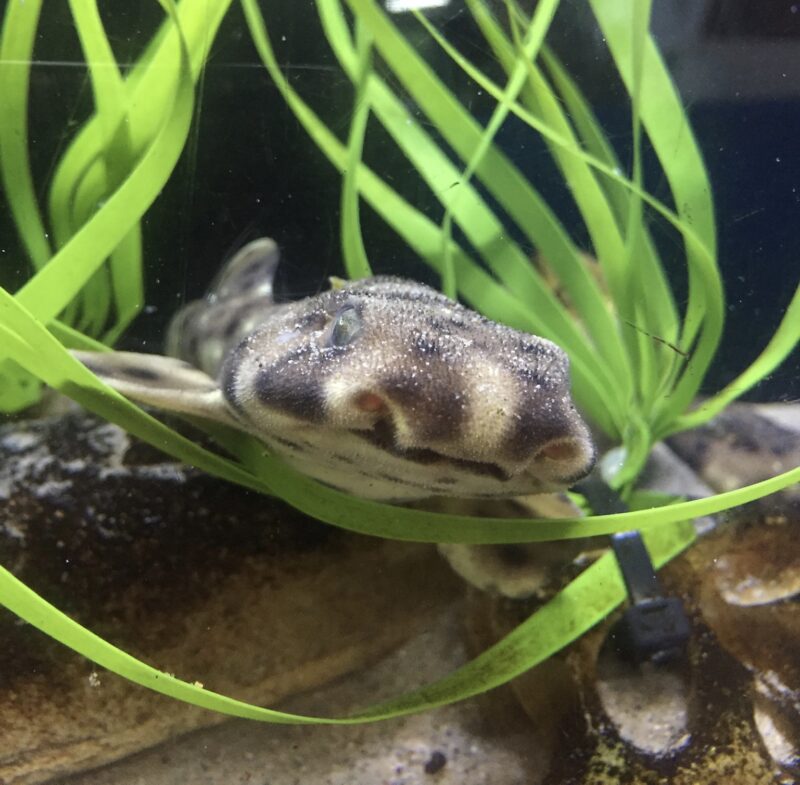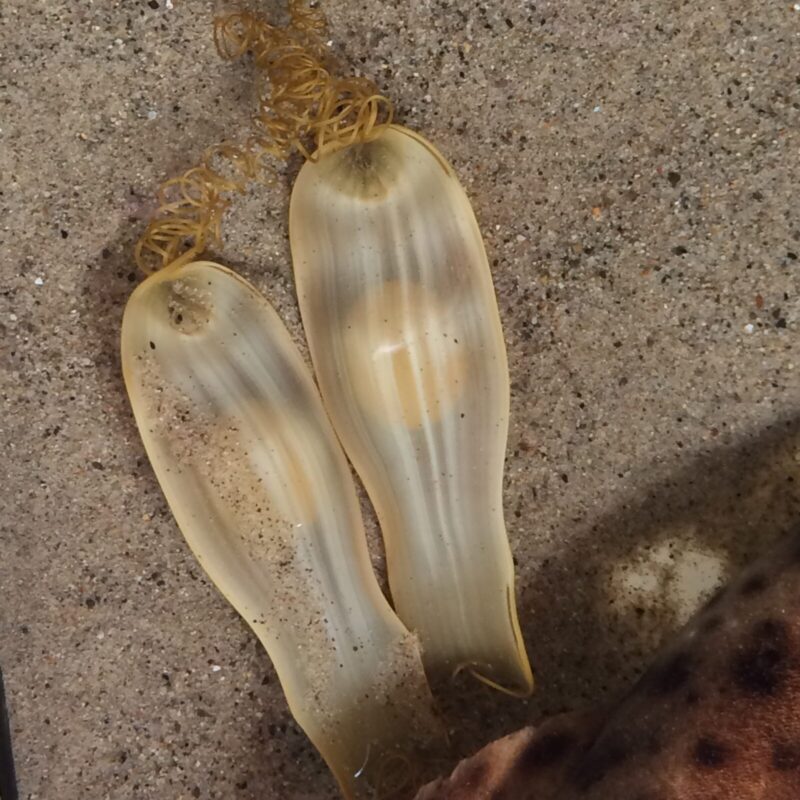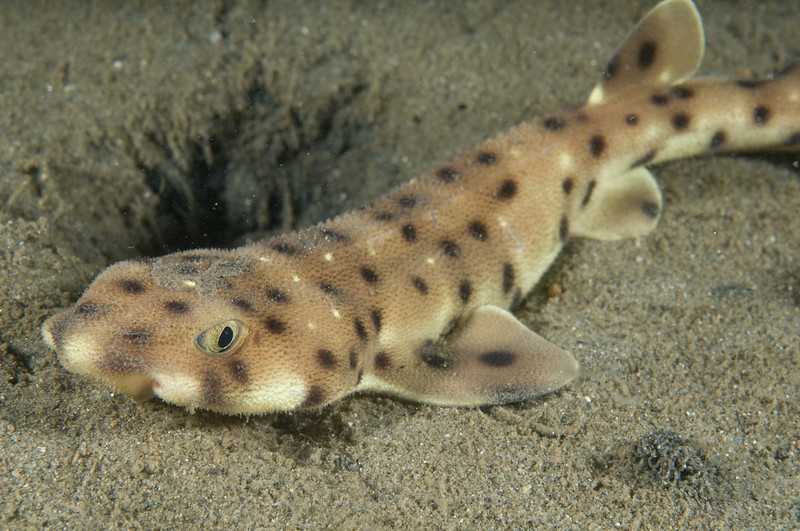It’s #SharkWeek, Every Week!

At Heal the Bay Aquarium, we believe that there are 52 Shark Weeks in a year, so we’re keeping all the #SharkWeek learning going. It’s important to share and teach facts, not fear, as we all work towards protecting our ocean environment and the animals that call it home. Shark conservation is a 24/7 job, so let’s continue this deep dive into learning more about these critically important, and often misunderstood, creatures.
California is known for its incredible richness and variety of ecosystems—both on land and under the sea. Venture across the Golden State and you’ll cross coastal wetlands, lush wooded forests, and the vast deserts in Death Valley. Dive below the waters off our coastline and see the fairytale-like beauty of our kelp forests, the infinite expansiveness of the sandy seafloor, and the rocky shore dynamics of our tide pools. From abalone, to sea lions, hermit crabs to Mola mola, there is a wealth of marine diversity right in our Bay.
So, who are our elasmobranch neighbors? In our local waters, there are at least 23 different kinds of sharks, and over a dozen types of rays and skates (the triangular-shaped Rajidae—not the retro kind spotted weaving down the boardwalk). Wade into our shallower waters and you may see the slim, spotted shadow of a leopard shark (Triakis semifasciata) sashay by, on the hunt for crustaceans and clams on the sandy bottom. Head out a little further with the surfers and you may even get the rare, incredible opportunity to spot our resident (albeit juvenile) landlord: the great white shark (Carcharodon Carcharias). From long-tailed thresher sharks to the chiropteran-like bat rays, you never know what you’ll “sea” when you explore our coast. At our Aquarium, we exhibit marine species that you can find right next door in Santa Monica Bay. Learning about these local animals allows our visitors to see what our clean water mission is all about: not only protecting public health, but also protecting the thousands of different kinds of marine life that call it home—from seabirds and fish, to marine mammals and phytoplankton—all are part of the southern California ecosystem.
Let’s meet the locals in our Sharks & Rays Exhibit!
Swell sharks (Cephaloscyllium ventriosum) are a visitor favorite because when you’re observing them in the exhibit, you’re now in the “Splash Zone”, due to the fact that they literally spit water while they swim around. They’re so aptly named because when agitated, swell sharks will hold on to their caudal fin with their teeth and swell up with water, making it more difficult for predators to bite them or pull them from their rocky den. Ever seen a Mermaid’s Purse? Swell sharks are also oviparous, which means they lay keratinous egg cases. Developing swell shark pups take about 9-12 months until they’re ready to hatch into adorable, 6 inch (15 cm) long baby sharks. Check out Baby Shark Watch to see a swell shark grow from egg to pup!
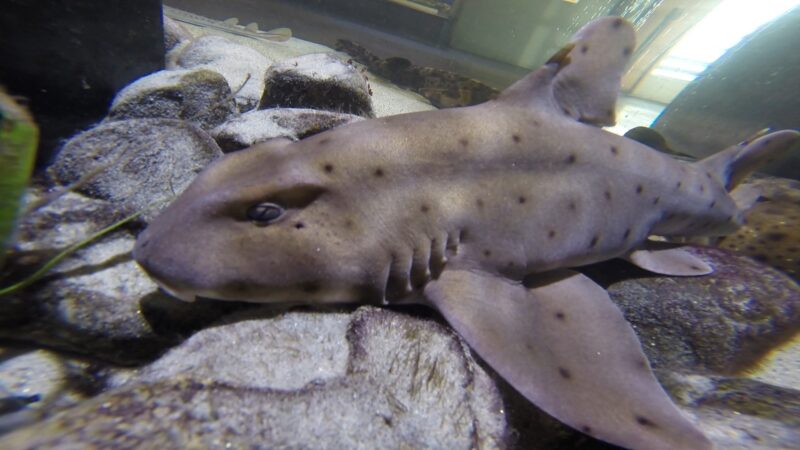
Horn sharks (Heterodontus francisci), are named for the large horns in front of each dorsal fin. These horns are used for protection against predators, making horn sharks extremely difficult to eat. Imagine trying to swallow a sandwich with the toothpicks still holding it together—you’d have a pretty hard time getting that down. These oviparous sharks also have a uniquely shaped mouth that allows them to “suck” in food and forage through sand for a tasty crab or some other buried seafloor invertebrate. The scientific name Heterodontus comes from the Greek words “heteros” and “odont”, meaning “different teeth”. Horn sharks have sharp pointy teeth in the front, and crushing molar-like teeth in the back. This is why they’re one of the few shark species that can actually eat a spiky sea urchin (sometimes staining their teeth with the urchin pigment).

Round stingrays (Urobatis halleri), lovingly known as “sea pancakes” by our visiting students, are commonly found in sandy bottom habitats, and typically hang around intertidal areas down to depths of about 15 m (50 ft). Stingrays are viviparous (live birth), and will have between 1-6 pups that are about the size of the palm of your hand (2.5-3 inches or 6-7.5 cm).
To the right, to the right…to the left, to the left…now shuffle! Ever heard of the Stingray Shuffle? It’s actually the best way to protect both yourself and unsuspecting stingrays that may be camouflaging in the sandy bottom below you when you head into the waves. If you slide or shuffle your feet in the sand as you enter and move about the ocean, rays will feel the movement from your feet, and will move somewhere else to avoid contact. If you walk in normally (especially around this time of year during stingray mating season), you may accidentally step on a ray, which will then defend itself by using the venomous barb on their tail. The venom of the round stingray is not dangerous to humans; however, it is extremely painful. If stung by a ray, the best course of action is to seek help from the nearest Lifeguard, and soak the affected area in very hot water. This actually denatures the proteins in the venom, and will hopefully help provide some relief from the sting. This is also the best treatment for sea jelly stings, since contrary to popular myth (and TV sitcoms), peeing on the jelly sting can actually make the pain worse!
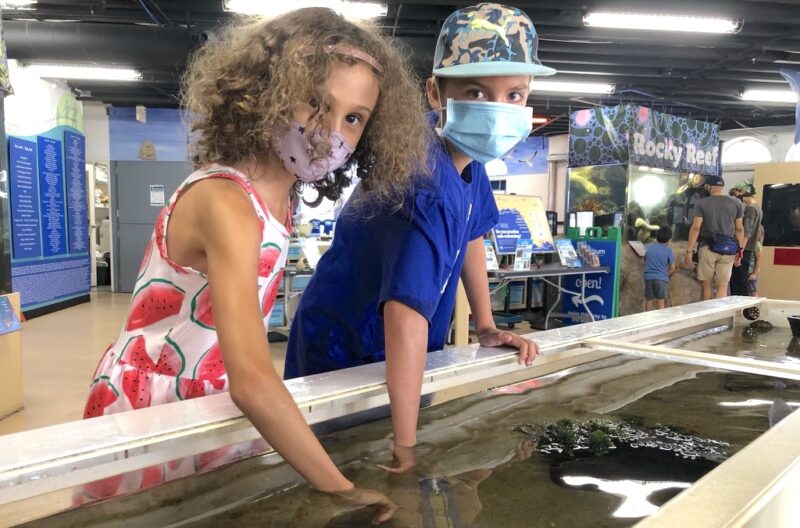
During our closure throughout 2020, we were busy at work refreshing our exhibits and creating fun, new experiences for our visitors for when we could safely reopen. We o-fish-ally re-opened our indoor gallery on June 12, 2021, and visitors can now enjoy our upgraded, interactive Sharks & Rays Touch Tank Exhibit! Get up close and feel the sandpapery touch of a swell shark’s skin from their dermal denticles (“tooth-skin”), or the velvety softness of a round stingray. Gentle interactions with these animals help to dispel long-held myths about sharks being scary, mindless, man-eaters.
Lurking. Stalking. Chasing. Attack. These are all familiar (and unfairly given) terms when we see any news about encounters between humans and sharks. Sharks have been around on this planet for at least 400 million years. They’re a keystone species, which means as apex (top) predators, sharks are critically important to a healthy ecosystem and marine food web. Just like the tumbling of a Jenga tower when we pull out a single, structural-load-holding piece, the removal of sharks can decimate the delicate balance of the ocean environment. We’ve seen the same impacts on land ecosystems with the human-led removal of wolves from Yellowstone National Park. Without these apex predators keeping elk populations in check, the land suffered from erosion and deforestation, affecting more than 200 other species of animals living in that ecosystem. Sharks usually take a long time to reproduce, and most don’t have that many young at a time. Female great white sharks usually aren’t even sexually mature for at least 1-2 decades, and their young take more than a year to gestate. Sharks are already vulnerable to the impacts of pollution and climate change, and data show that worldwide shark populations have declined by almost 99% due to the additional stress of overfishing.
So, what can we do to help protect sharks? One super easy way is to spread facts, not fear. Even though encountering sharks in the wild can still be a scary thought, sharks have no desire to eat us (honestly—do we really think we taste that good?). Sharks are actually probably much more afraid of you than you are of them, and when they encounter people, their usual reaction is to swim away, hide, or out of simple curiosity just check out this silly-looking animal scooting around the water. Being conscientious about sustainable seafood choices, and going zero-waste and plastic-free as much as possible can go a long way towards shark protections. Destructive fishing methods not only cause habitat loss, but harms millions of sharks each year as bycatch. Just looking at the Pacific Ocean alone, an estimated 3.3 million sharks are accidentally caught each year as bycatch on longlines that were targeted for other fish. Supporting bans on shark fin products and shark finning can also add protections to critically declining shark populations, because we can eliminate the market for fins by passing laws prohibiting their sale. Globally, at least 70-100 million sharks are killed each year just for the inhumane shark fin trade. Heal the Bay, along with partners and supporters, successfully led the charge to ban the sale and possession of shark fins in California in 2013. Right now, the Shark Fin Sales Elimination Act (H.R. 737) is still waiting for a vote in the Senate. The House passed this bill in November 2019, and the bill would “prohibit the sale, purchase, and possession of shark fins in the United States”. Your voice and action can help protect what we all love. Helping to teach others about the importance of sharks is a great way to help change the way people think about sharks. For the record, we think they’re “swell”.
Learn more about shark conservation with these great organizations and researchers:
Citations:
- https://www.smithsonianmag.com/travel/how-fix-jellyfish-sting-180963582/#:~:text=And%20before%20you%20ask%3A%20no,consistent%20chemical%20makeup%2C%20she%20says
- https://www.congress.gov/bill/116th-congress/house-bill/737/text



